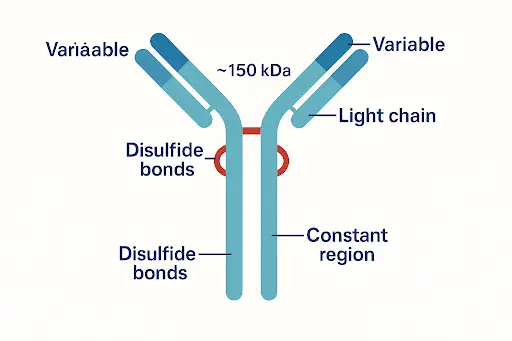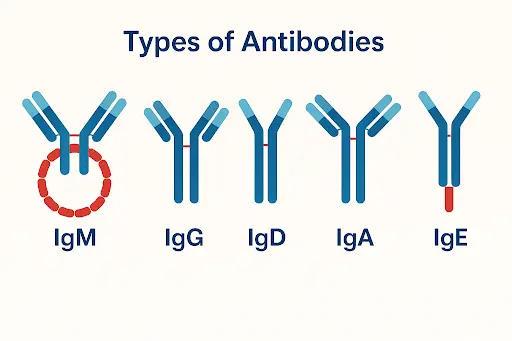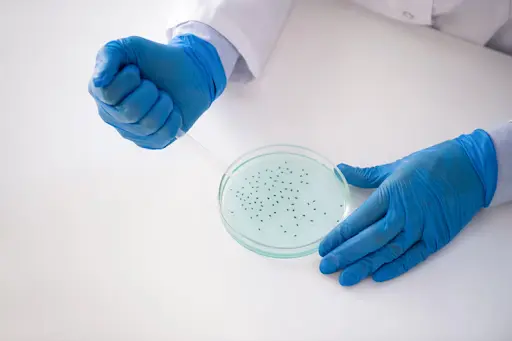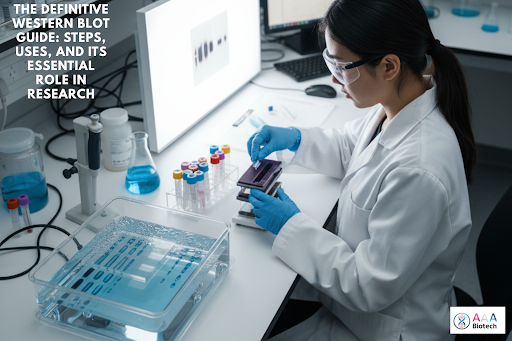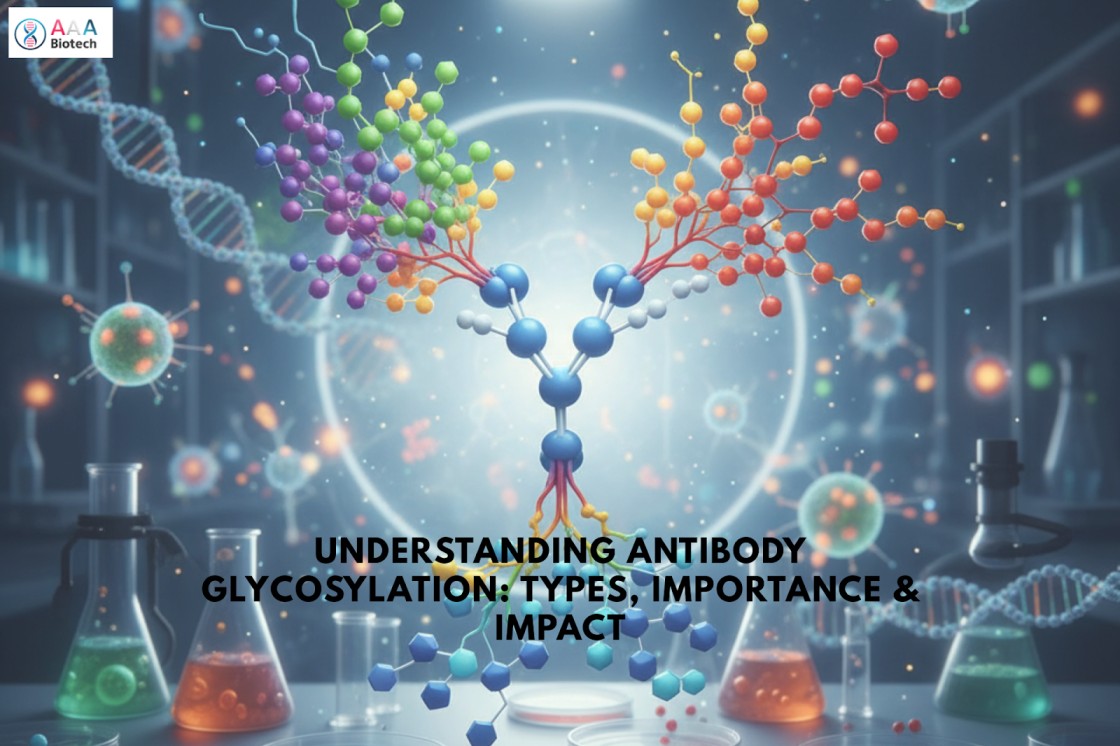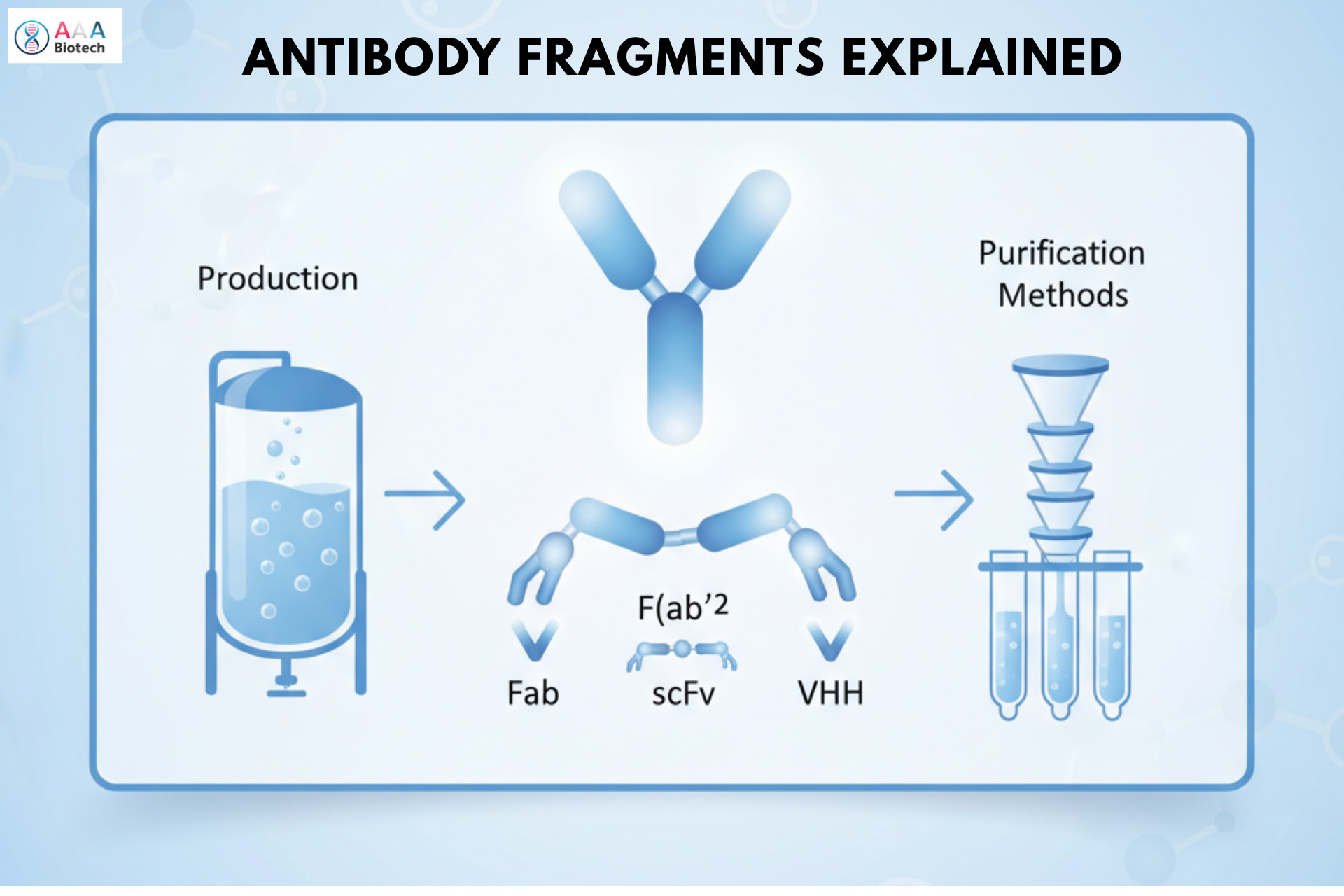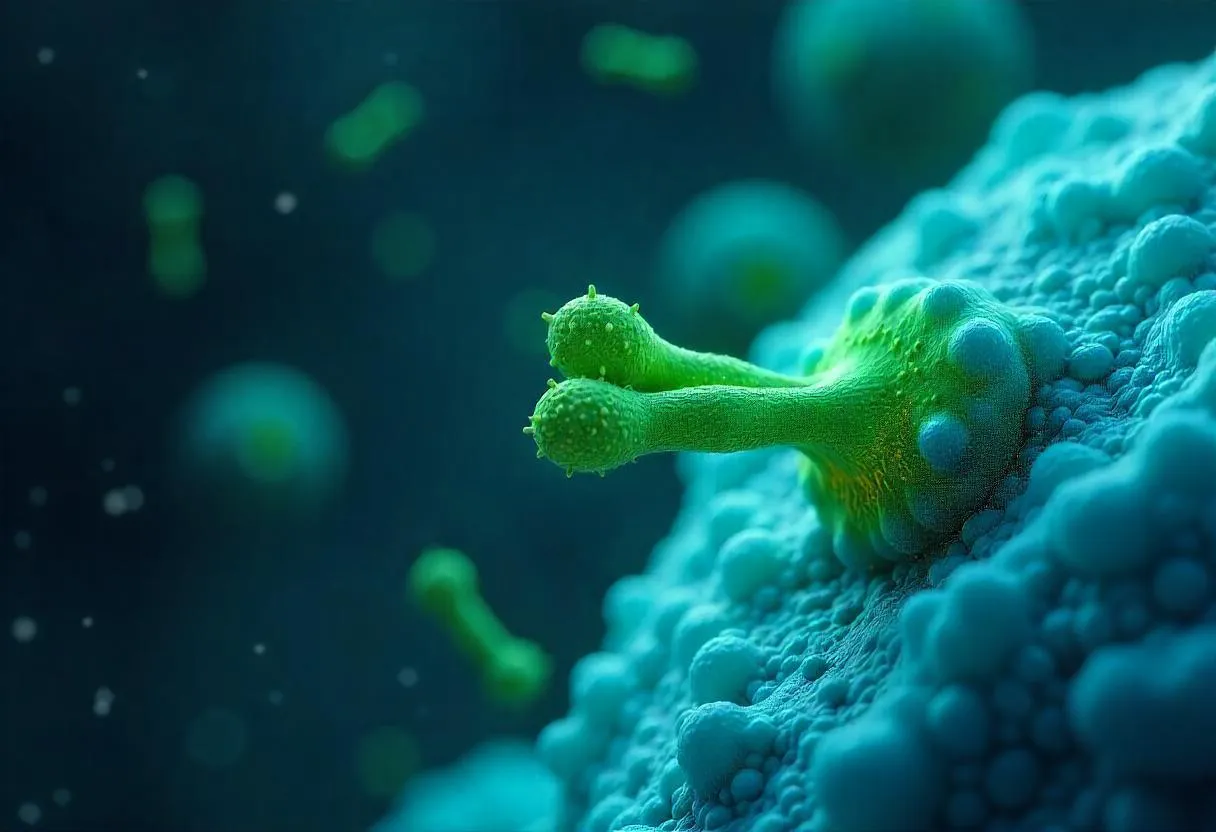What Are Antibodies: Structure, Function & Types
In this Article
All of the products listed in AAA Biotech’s catalog are strictly for research-use only (RUO).

An antibody is a protein that helps protect the body internally.
Key Takeaways
- Antibodies are proteins that defend the body against harmful invaders.
- Each B cell makes antibodies for one specific antigen.
- Antibodies recognize and bind to antigens (the vast majority of which are “foreign”) and help remove them.
- Antibody structure is Y-shaped with two antigen-binding sites.
- Five main types of antibodies: IgG, IgM, IgA, IgE, and IgD.
- Antibodies are routinely used in diagnostic tests and disease detection.
- Vaccines help the body generate specific antibodies for future protection.
So, What Are Antibodies?
They are produced by the immune system when harmful substance, referred to as an antigen enters the body.
Antibodies find and bind to these antigens to help remove them. Antigens can be many things, like “germs” (or pieces of said germ) that can cause disease or poisons such as venom from insects and other animal species.
Here is what you need to know -
How Antibodies Work?
When something foreign, such as a virus or bacteria, enters the body, the immune system can recognize that it is not a “normal” component of the body, as it will “look” different on the surface. To fight it, the immune system uses several tools — one of which (and arguably, the most important) being antibodies.
Antibodies are made by special white blood cells called B cells (or B lymphocytes).
When a harmful substance (again, referred to as an antigen) is presented to and binds to specific components on the surface of a B cell, the B cell becomes activated.
This B cell then makes many copies of itself. These copies, called plasma cells, start releasing millions of antibodies into the blood and lymph (a fluid that helps fight infections).
What Antibodies Do?
Antibodies travel through the body looking for antigens that match the one that started the immune response that produced them. They attach to these antigens and help neutralize them in different ways:
1. Antitoxins: Some antibodies can neutralize poisons (toxins) by changing their chemical structure.
2. Blocking invaders: Other antibodies bind to germs and stop them from moving and/or entering the body’s cells.
3. Calling for help: Sometimes, when antibodies cover an invader, they trigger a chemical reaction called the complement system. This can:
- Cause the pathogenic invader to burst open.
- Attract special immune cells to swallow and subsequently “eat” (destroy/dissolve) the invader.
Once this process starts, antibody production continues for several days — until
the body detects that it has removed all of the antigen that it originally
recognized. After that, the antibodies stay in the body for months, giving
long-lasting protection against that same invader.
Antibodies and B Cells
B cells and antibodies are an immensely powerful team that the immune system can deploy.
Their main job is to spot harmful invaders (antigens) and produce large quantities of antibodies to help remove said invaders from the body.
- Each B cell can only recognize one specific type of antigen, but the body has many (many!) different B cells, so together they can detect almost any invader.
- B cells recognize antigens using special proteins on their surface called antigen receptors. These are like built-in antibodies that stay attached to the B cell’s surface.
How B Cells Recognize Antigens?
- All of the antigen receptors on a single B cell are the same.
- Different B cells have slightly different receptors that can recognize slightly different parts of different antigens.
- The part of the antigen that a B cell’s receptor binds to is called an epitope (or antigenic determinant). This “epitope” is essentially just a very specific small piece of the antigen’s surface.
For a B cell to respond, the “shape” of its receptor must complementarily match
the “shape” of the epitope, like pieces of a puzzle.
If they fit, the B cell becomes activated and begins making its antibodies (that will have the same specificity as its receptor).
Antibody Structure
An antibody has a Y-shaped structure made of four protein chains — two heavy chains and two light chains, arranged in pairs.
At the top “arms” of the Y (also referred to as the N-terminus of the heavy chains), each heavy chain joins with a light chain to form the antigen-binding sites. These are the two arms of the Y and are known as the Fab (fragment antigen-binding) regions. They are the parts of the antibody that attach to foreign substances like viruses or bacteria.
The bottom part of the Y (also referred to as the C-terminus of the heavy chains) is called the Fc (fragment crystallization) region. This part helps the antibody bind to immune cells which aids the body in destroying the invading pathogen.
All four chains are held together by chemical bonds, including a strong variety known as “disulfide” bonds.
The heavy chains have a variable region, which changes between different antibodies so they can recognize different threats, and three constant regions, which stay mostly the same. Each antibody has two identical binding sites, and these sites vary depending on what the antibody is intended to target.
For brief overview, here is a helpful piece of media to elaborate on what you
need to know -
What Are The Different Types of Antibodies and What Do They
Do?
Human antibodies are grouped into five types based on their heavy (H) chains. These human types are:
IgG, IgM, IgA, IgE, and IgD
Each type has a different structure and role in the immune system’s response.
IgG – Main Defender in the Blood
- Most common antibody in the blood (about 70–75%).
- Helps neutralize toxins and fight infections.
- Helps white blood cells (like macrophages) recognize and destroy threats.
- It can cross the placenta from mother to baby and protects the baby before its own immune system can do so by itself.
IgM – First Responder
- Makes up about 10% of the antibodies in the blood.
- It’s the first antibody made when there’s an infection detected.
- Has a pentamer conformation (5 Y-shaped units joined together), which allows it attach to many germs simultaneously.
- Even though it doesn’t bind to target pathogens as strongly/tightly as IgG, its shape gives it strong overall binding power (due to it having 5 antibodies bound together).
- Also helps send signals within immune cells when it binds to an antigen.
IgA – Mucosal Protector
- Found in mucus, saliva, tears, breast milk, and fluids in the gut.
- Makes up 10–15% of antibodies.
- Has a dimer conformation (two IgA antibodies are linked).
- In breast milk, IgA protects the baby’s digestive system from germs.
IgE – Allergy and Parasite Fighter
- Found in tiny amounts (less than 0.001% of antibodies).
- Originally evolved to fight parasites.
- In places without much incidence of parasites, it mostly is responsible for allergic reactions (like hay fever, asthma, and food allergies).
IgD – Still a Mystery
- Very rare, making up less than 1% of antibodies.
- Believed to help activate B cells, but scientists are still figuring out exactly what it does.
| Antibody Type | IgG | IgM | IgA | IgE | IgD |
| Heavy Chain Name | Gamma (γ) | Mu (μ) | Alpha (α) | Epsilon (ε) | Delta (δ) |
| Size (Molecular Weight) | Medium (150 kDa) | Very Large (900 kDa) | Large (385 kDa) | Small (200 kDa) | Small (180 kDa) |
| Antigen Binding Sites | 2 | 10 | 4 | 2 | 2 |
| Amount in Blood | Most common (80%) | 6% | 13% | Very little (0.002%) | 1% |
| Activates Complement System | Yes | Yes | No | No | No |
| Where It's Found | In the blood and body fluids | Mostly in the blood | In body fluids like tears, mucus, and saliva | Bound to allergy cells (mast cells, basophils) | On the surface of B cells |
| Main Job | Fights infections in the blood, neutralizes toxins, helps immune cells attack germs | First antibody made when you're sick, helps activate other immune responses | Protects surfaces like the nose, mouth, and intestines from infection | Involved in allergic reactions and fights parasites | May help start B cell responses (still not fully understood) |
Antibodies in Medicine and Research
Antibodies are very useful in both medicine and scientific research.
For example, doctors can use ready-made antibodies (taken from the blood of people or animals who have recovered from certain infections) to give someone immediate protection. This is called passive immunity, and it’s used in emergencies — like treating snakebites or tetanus — where the body needs immediate help to fight harmful toxins or pathogens.
On the other hand, vaccines work by giving your body a “preview” of a dangerous pathogen. This helps your immune system by giving it a “blueprint” for rapidly defending against this pathogen in case it encounters it in the future. Once the vaccine does its job, certain immune cells (called B cells) will be ready to make antibodies quickly if the real infection shows up later.
Monoclonal Antibodies – Lab-Made and Powerful
Monoclonal antibodies are special antibodies made in the lab using genetic techniques. They are designed to recognize and stick to one very specific target, such as a piece of a virus, a cancer cell, or even a drug molecule.
Because they are so specific, scientists can use them to:
- Test for tiny amounts of substances in blood or tissue samples.
- Identify different types of cells, including cancer cells, by spotting unique markers on their surface.
Frequently Asked Questions
Can Antibodies Be Used to Detect Diseases?
Yes, they can. Antibodies are an important part of the immune system, and doctors can use them in lab tests to find out if someone has or had a specific disease. These tests look for antibodies that form in response to infections or other health conditions.
How Long Do Antibodies Stay in the Body?
After fighting off an infection, your body keeps some antibodies around to help protect you in the future. How long they stay depends on the disease — for some illnesses, antibodies may last only a few months, while for others, they may remain for years.
Are Antibodies Used in COVID-19 Testing?
Yes, but not for diagnosing current infections. Antibody tests (or serology tests) check if someone has had COVID-19 in the past by detecting antibodies in their blood.
These tests show whether the immune system responded to the virus, not whether the person is currently sick.
“Antigen” tests can also utilize lab-made antibodies to determine if someone’s body still has active virus.
How Are Antibodies Made for Medical Use?
Scientists can make antibodies in the lab, especially monoclonal antibodies (mAbs), using advanced methods like hybridoma technology or recombinant DNA techniques.
These enable the large-scale production of specific antibodies used in research, testing, and treatment.
Can Antibodies Be Used to Treat Cancer?
Yes, particularly monoclonal antibodies. They can be designed to target cancer cells specifically, either by:
- Marking them for the immune system to attack,
- Blocking signals that help cancer grow or
- Delivering chemotherapy drugs directly and specifically to the cancer cells.

